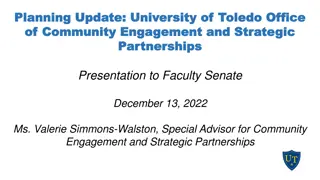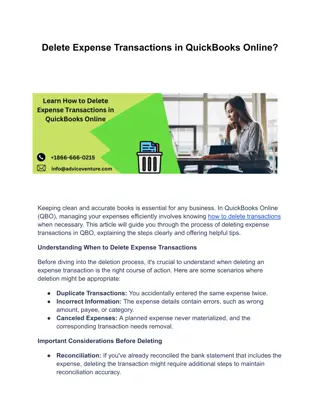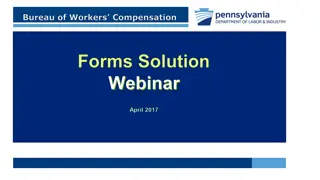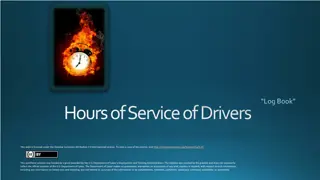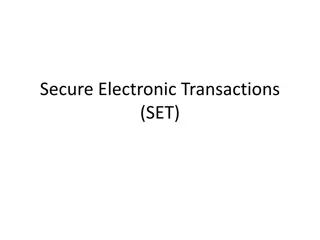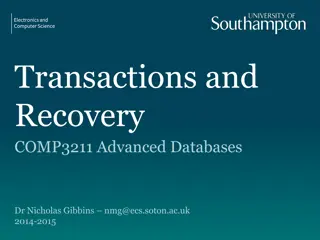Evolving Strategic Transactions: Environmental Drivers and Approaches
Strategic transactions in healthcare are influenced by market drivers such as cost pressures, population health needs, and quality goals. Explore various approaches and challenges in aligning strategies with changing market dynamics.
Download Presentation

Please find below an Image/Link to download the presentation.
The content on the website is provided AS IS for your information and personal use only. It may not be sold, licensed, or shared on other websites without obtaining consent from the author.If you encounter any issues during the download, it is possible that the publisher has removed the file from their server.
You are allowed to download the files provided on this website for personal or commercial use, subject to the condition that they are used lawfully. All files are the property of their respective owners.
The content on the website is provided AS IS for your information and personal use only. It may not be sold, licensed, or shared on other websites without obtaining consent from the author.
E N D
Presentation Transcript
Evolving Strategic Transactions: Environmental Drivers and Approaches for Matching Strategy to Market Changes W. Kenneth Davis, Jr. Partner, Health Care Practice Katten Muchin Rosenman LLP +1.312.902.5573 ken.davis@kattenlaw.com Laura Keidan Martin National Head, Health Care Practice Katten Muchin Rosenman LLP +1.312.902.5487 laura.martin@kattenlaw.com
Agenda Rationale for Strategic Transactions Next Gen CINs Service Line Horizontals and JOAs Verticals with Physicians, Post-Acute Care Providers and Ambulatory Care Companies Ambulatory Care Arrangements 1
Market Drivers for Strategic Transactions Downward pressure on cost and reimbursement Population health management imperatives Efficiency objectives Desire to expand geographic footprint Access to expertise Quality and patient satisfaction goals Physician engagement Obstacles to full merger or acquisition Desire for short-term alignment that keeps merger possibilities open down the road 2
Consolidated CIN Health System Transfer of IP, contracts and other assets Transfer of IP, contracts and other assets System Wide Newco CIN OldCo CIN OldCo CIN Board of Directors Finance and Operating Committee Credentialing Committee Quality Committee Input Input Advisory Council Advisory Council Advisory Council Advisory Council Advisory Council OldCo CINs associated with individual hospitals are merged or consolidated with system-wide Newco CIN or simply dissolved. System-wide CIN has Board, committee and advisory council structure that ensures input on credentialing standards, clinical protocols, benchmarks and incentive distribution methodologies by employed and independent physicians in each region. The advisory councils may be based on locality, potentially with sub-committees based on specialty so that PCPs talk to PCPs and specialists talk to specialists. The advisory councils make recommendations within general parameters set by the CIN Board and all recommendations would be subject to approval by the Board and/or a Board committee. The advisory councils also serve as vehicles for grassroots physician outreach and involvement. 3
Diversified CI Strategy Health System Participation Agreement Health Plan (Independent or Affiliated) Infrastructure Infrastructure Hospital Physician Group CIN CI MSO ACO MSO Service HEIP Agreement Agreements Participating Providers Care Coordination Services Smaller Independent CINs Independent Groups IPAs PA Addenda Payor Contract Independent Groups Independent Groups Health System operates a single CIN but may maintain a separate ACO for MSSP contracting. The CI MSO (or CIN via subcontract with MSO) provides clinical integration and back office infrastructure to the ACO and CIN, as well as a variety of MSO services to independent physician groups. The MSO also might provide care coordination services to high risk populations serviced by independent or affiliated health plan(s) that contract with the CIN. The CIN enters into participation agreements with physician group affiliate and a variety of independent provider entities, potentially including independent groups, IPAs and other CINs. The participation agreements may guarantee a certain number of CIN Board, committee and/or advisory council seats to various participating provider constituencies. When IPAs, independents or CINs contract with the CIN, individual physician groups will sign participation agreement addenda agreeing to abide by the terms of the participation agreement. The CIN may form different panels of participating providers for different payor products and/or for Hospital Efficiency Improvement Program ( HEIP ) incentives. The CIN also may have one or more profit pools or incentive distribution methodologies based on geographic specialty, payor product and/or employment status. A single CIN entity may be used for MSSP and commercial payor contracting if all participating providers agree to abide by MSSP standards. 4
Federated or Super CINs Health System 2 or For Profit CI CO Health System 1 Network Subcontract Agreement Network Subcontract Agreement Newco CI Collaborative CIN1 CIN2 or CI MSO Support Services Agreement Support Services Agreement CIN1 Participating Providers CIN2 Participating Providers Health System 1 forms a Newco ( Newco CIN ) with Health System 2 or a Clinical Integration Company ( CI Co ) to develop a federated CIN with a best practice clinical integration program. Newco CIN Board and committees would be comprised of party representatives. Newco CIN would adopt a single clinical integration program that would apply to both CINs participating providers when providing care under Newco CIN contracts. This model allows Newco CIN to contract on behalf of both sets of CIN participating providers. However, antitrust compliance policy is important to minimize risk of anticompetitive spillover effects. These arrangements often include exclusivity provisions prohibiting similar CIN arrangements with other hospitals and health systems within a specified territory. Support services and infrastructure necessary to operate the Newco CIN may be provided by either party s CIN or CI MSO entity. 5
Key Regulatory Parameters: CIN Considerations Regulatory Parameters CIN Considerations Anti-Kickback Statute The AKS is an intent-based statute that makes it unlawful to offer, pay, solicit or receive remuneration in return for referrals or for purchasing, ordering, recommending or arranging for an item or service payable under a federal health care program. Arrangements that meet safe harbors or ACO waivers are immune from AKS attack: Bona fide employees. Personal services arrangements that set aggregate FMV compensation in advance. ACO pre-participation, participation and shared savings distribution waivers. Non-safe harbored arrangements are subject to scrutiny to determine if one purpose is to incentivize or reward referrals or business generation. Health system funded CINs that are intended to drive referrals to health system facilities may implicate the AKS. Stark Act Prohibits physicians from making referrals for designated health services ( DHS ) payable by Medicare to entities with whom they have a financial relationship, unless an exception applies. Compensation paid to physicians by an entity that does not provide DHS results in a financial relationship only if compensation varies based on the volume or value of referrals to DHS entities in a chain of financial relationships with the non-DHS entity. Thus, CIN payments to physicians that do not vary based on the volume/value of DHS referrals to any DHS entity do not create a financial relationship with any DHS entity. However, if financial relationships related to CIN start up are with a DHS entity, or compensation varies based on the volume/ value of referrals to a DHS entity (e.g., a cost reduction per case bonus), then the relationship must be structured to qualify for ACO waiver or satisfy a Stark Act exception, such as: Risk sharing arrangements Isolated transactions Physician incentive plans Indirect compensation 6
Key Regulatory Parameters: CIN Considerations Regulatory Parameters CIN Considerations Civil Monetary Penalty Provisions Apply to hospitals that knowingly [make] a payment, directly or indirectly, to a physician as an inducement to reduce or limit medically necessaryservices to Medicare or Medicaid beneficiaries and to physicians who accept such payments. CIN incentives that operate to reduce medically necessary services generate CMP exposure unless ACO waiver applies, making safeguards against such reductions essential. Tax Exemption Any private benefit from tax exempt entity to non-exempt entity or individual must be merely incidental to accomplishment of charitable purpose. Tax-exempt organization s activities cannot inure to the benefit of insiders. Disqualified Persons who exert substantial influence and control over exempt organizations cannot receive compensation in excess of FMV. Tax exempt health system charitable assets cannot be used to fund or support the CIN in a manner that primarily benefits physicians and non-exempt entities. Antitrust Barscontracts, combinations, conspiracies and other concerted action in restraint of trade. Payor contracting by CINs that do not involve significant risk sharing and are not clinically integrated may be attacked as per se unlawful price fixing. Accordingly, CINs with non-risk based contracts must have a CI program to evaluate and modify the clinical practice patterns of physician participants and create a high degree of interdependence and cooperation to control costs and ensure quality. CINs also should have antitrust compliance policies to prevent the inappropriate sharing of competitively sensitive information and agreements that reduce competition. 7
CIN Financial Arrangements with Regulatory Implications Hospital funding of CIN start up and operating expense. Physician equity investments in CIN at start up. Transfer of equity interests to physicians or for profit following CIN implementation. CIN technology subsidization for physician participants. Payments to physicians for service on CIN steering committees during start up and on Board/ CIN committees following formation. Payments to physicians under HEIP. CIN payor incentive distribution methodologies. MSO arrangements between CIN and health system. FMV is key to compliance with AKS, tax exemption and potentially parameters. 8
Risk Mitigation Strategies for CINs Document the CIN s community benefits and legitimate business purposes, consistent with your organization s tax exempt purposes and population health management objectives, quality and cost savings objectives. Regardless of whether your CIN participates in the MSSP, adopt Board resolution patterned on ACO waiver requirements. Consider mechanisms to minimize health system financial subsidization, such as: Physician membership fees, dues or credentialing fees to offset start up/operating costs. Structuring start up funding as loan or refundable capital contribution to be repaid once CIN revenue streams are in place. Incentive payment pool withhold to offset start up and operating costs. 9
Risk Mitigation Strategies for CINs Document all physician service arrangements (e.g., for service on the CIN Board) in a written, FMV agreement. Structure incentive distribution methodologies to avoid: Case volume thresholds for network participation and bonus distributions. Avoid variable per case, per admission and other volume-based distribution methodologies that might be reviewed as referral incentives. Instead focus on: Shared savings goals (not tied to volumes) Verifiable quality and outcomes metrics Participation in CI initiatives Patient disclosures regarding CIN incentives would reduce risk. Consider limiting contracting efforts to commercial payors to reduce risk. Adopt utilization criteria/review that focus on underutilization (not just overutilization) and penalize failure to provide medically necessary care. Consider liberal position on exclusivity and in-network referrals to reduce risk (balancing such position against population health management goals). Obtain valuations to support equity transfers and novel payor incentive distribution methodologies, HEIP arrangements and service arrangements. 10
Service Line Collaboration Models (MSO and JOC) Health System 2 Health System 3 Health System 1 MSA/JOA Newco Outpatient JV The parties form a new management company ( Newco ) to jointly manage certain service lines. Each party appoints a certain number of Newco Board members. Under the MSO version of the model, Newco enters into management services agreements ( MSAs ) with each of the parties to provide management services and coordinate care across delivery sites within selected service lines, but would not serve as a vehicle for joint strategic planning, payor contracting, service consolidation or budgeting. Newco charges each party a management fee based on an agreed upon formula. Under the joint operating company ( JOC ) version of the model, the parties enter into a joint operating agreement ( JOA ) under which Newco would serve as a vehicle for joint decision making and strategic planning for the designated service lines, subject to certain mission and major powers reserved to the parties. This model requires Financial and clinical integration across sites of service. The JOC would have the authority to determine the most appropriate and cost-effective sites of service to deliver care to the population. Revenues and expenses might be pooled and distributed in accordance with a predetermined formula. Under either version of the model, Newco also might serve as a vehicle for joint venturing certain outpatient programs and facilities (e.g., behavioral health clinics, children s outpatient center, lab and outpatient rehab). 11
Comprehensive Joint Operating Company Health System 1 Health System 2 Continued Ownership of all Assets and Liabilities Continued Ownership of all Assets and Liabilities JOC JOA JOA Health System 1 HoldCo Health System 2 HoldCo Hospital D Hospital E Hospital F Hospital A Hospital C Hospital B The parties form a new JOC in which they are the sole corporate Members. Each party appoints a certain number of JOC Board members. The parties enter into JOA under which the JOC manages each party s health care facilities and programs across the full spectrum of care. The JOC Board would make decisions on strategic plans, budgets, CI initiatives, asset acquisitions/ dispositions, service configurations and the like for the joint enterprise. However, certain mission powers and major decisions are reserved to the parent Boards. Assets remain on the balance sheets of each legacy entity, and the legacy boards remain intact. Financial integration is accomplished through a contractual formula for sharing the risks and rewards of the integrated enterprise. Under a Single Entity version, JOC becomes sole corporate member of each HoldCo. Health Systems execute certain mission reserve powers over legacy assets and appoint inter JOB Boards, which becomes self perpetuating. 12
JOC Models: Antitrust Considerations There are two basic, legally viable versions of the JOC model: 1) A Single Entity JOC model that results in a complete unity of economic interest among the JOC and the legacy subsidiaries of each HS Parent. Under this model, the JOC must be vested with sufficient authority to create the functional equivalent of a parent-subsidiary relationship with the legacy subsidiaries. Because a parent and its subsidiaries are legally incapable of concerted action, JOC activities (e.g., payor contracting, service allocations) would be immune from antitrust challenge. 2) A JOC JV model that is treated as a joint venture under the antitrust laws. JOCs that do not qualify for single entity status must involve sufficient clinical and/or financial integration so that they are not treated as per se illegal price fixing, market allocation or group boycott vehicles. JOCs that are sufficiently integrated to clear the per se illegal hurdle remain subject to rule of reason scrutiny under 1 to determine whether any anticompetitive effects associated with JOC activities are outweighed by efficiencies and consumer benefits. In some states, there may be a Certificate of Public Advantage statute that conveys state action protection to JOC. 13
Verticals 14
Why Pursue Provider Verticals? Tremendous volume and velocity of change in all areas of health care, beyond traditional hospital services Some of the drivers: Health care "reform Federal scrutiny of various types of services Reimbursement pressure from all governmental and non-governmental payors More, and more expensive, technology Heightened tension as hospitals acquire/consolidate physician practices ACOs, CINs and other integrative efforts 15
Who are Hospitals Participating With Physicians, post-acute providers and ambulatory care companies Tax-exempts and for-profits Publicly-traded Private equity Payors (more in a moment) 16
How Have The Provider Verticals Changed Structurally Partnership is the name of the game Control is less important Focus is on alignment of incentives Greater willingness to consider atypical partners More flexibility in sources of financing Welcome private equity 17
How Have The Provider Verticals Changed Structurally (cont d) Build for value-based reimbursement Requires a fundamentally different mindset Data is king Need to gather actionable data even if the government isn t paying for you to do so For example, must be able to demonstrate the particular vertical s contribution to population health management 18
Verticals Involving Payors and Providers Why consider these types of strategies: Nationally, change is being driven by major players on both sides of the equation: Those who provide Those who pay Reimbursement is moving from fee for service to value-based Also, more risk is being offloaded by payors and/or proactively sought out by providers If you can manage risk effectively, then you can make more money As a result, it makes sense for payors and providers to work together more closely 19
Verticals Involving Payors and Providers (contd) Some strategies: Provider builds a new, controlled HMO or insurance company Joint venture between the payor and the provider, that may have the following function(s): Network development and/or management Build a jointly-owned, new HMO/insurance company Expansive risk sharing, through the joint venture, across the full spectrum of health care Standard contract-based participating provider relationship, but much broader and more integrated As an example, hospital system (possibly through a CIN) accepts expansive risk for full spectrum of health care 20
Morphing of Hyper-Focused Strategies: An Example 21
The Example: Diagnostic Imaging Diagnostic imaging is an area of outpatient or ambulatory care in which everyone is looking for ways to compete more effectively and survive downward reimbursement pressures For many hospitals and health systems, it s one area where they are still generating decent margins/profits Note: This example works best with non-referring participants (e.g., diagnostic radiologists, private equity sponsored companies, etc.) It illustrates that a hyper-focused strategy often requires rapid morphing in how important services are provided and billed for 22
Some Historical Context Hospitals had most often billed for the technical component (the TC ) of imaging as an outpatient service under Part A In some instances, hospitals would joint venture with radiologists or other participants for outpatient imaging, and the joint venture itself would enroll and bill the TC under Part B as a supplier (i.e., as an independent diagnostic testing facility [an IDTF ] or as a diagnostic radiology group practice clinic [a DRGPC ]) 23
Some Historical Context (contd) DRA 2005 reduced TC reimbursement for suppliers to the lesser of . . . Multiple procedure discounts under Medicare have also reduced reimbursement for suppliers Non-governmental payor reimbursement to suppliers followed Medicare down, either automatically (through fee provisions) or by negotiation 24
Some Historical Context (contd) By contrast, at least historically, hospitals very often have received reimbursement from non-governmental payors that is significantly higher than what suppliers receive Ironically, changes in imaging deal structures over the past decade have been driven by Medicare: DRA 2005 had the effect of all but equalizing outpatient reimbursement for suppliers and hospitals Rather, it was the advantages for hospitals on the nongovernmental side that was the big driving force The question we have always advised our clients to ask: how long-lived is this arbitrage opportunity? 25
Some Historical Context (contd) And now: Site neutrality has fully equalized Medicare reimbursement (subject to some grandfathering) In 2017, at least one major non-governmental payor announced that it won t pay for MRI or CT in hospitals unless it can be shown that it is medically necessary to perform the test in a hospital Many hospitals have started taking a longer view on outpatient imaging, and on any arbitrage 26
Some Historical Context (contd) Everyone is looking for ways to squeeze out additional revenue and profit/margin Indeed, with the recent payor announcement, many hospitals will simply be looking for a way to provide and get paid for the service Morphing can make this happen 27
Factual Scenario No. 1 Existing hospital/radiology group joint venture, enrolled with Medicare as either an IDTF or a DRGPC, morphs Variation: a hospital could buy partially into a center owned/operated by a radiology group (or other participants such as a private equity sponsored company), and then the resulting joint venture morphs 28
Factual Scenario No. 2 Existing hospital outpatient services, owned by one or more hospitals, and existing IDTFs, and DRGPCs (owned by one or more radiology groups, hospitals and/or other participants) are contributed into a new joint venture In return, the previous owners become new owners of the joint venture pro rata to the value of the businesses (and any other assets/cash) contributed The new joint venture morphs 29
The Morph During the years immediately following DRA 2005, the joint venture would operate the imaging locations post-closing as provider-based or under arrangement Today, because of recent market developments, and with a long view on imaging, the joint venture could be structured as a reverse under arrangement What s the difference? 30
Legal Considerations Provider-based rules Under arrangement statute (and restrictions) Medicare enrollment requirements State hospital licensure laws State CON laws (if any) Private use limitations (if any) Collective bargaining agreements Payor contract terms and conditions Can you add the location? Will the morph address nongovernmental payor limitations? 31
Katten Muchin Rosenman LLP Locations AUSTIN 111 Congress Avenue Suite 1000 Austin, TX 78701-4073 +1.512.691.4000 tel +1.512.691.4001 fax DALLAS Comerica Bank Tower 1717 Main Street Suite 3700 Dallas, TX 75201-7301 +1. 214.765.3600 tel +1. 214.765.3602 fax LONDON Paternoster House 65 St Paul s Churchyard London EC4M 8AB United Kingdom +44.0.20.7776.7620 tel +44.0.20.7776.7621 fax NEW YORK 575 Madison Avenue New York, NY 10022-2585 +1.212.940.8800 tel +1.212.940.8776 fax SHANGHAI Suite 4906 Wheelock Square 1717 Nanjing Road West Shanghai 200040 P.R. China +86.21.6039.3222 tel +86.21.6039.3223 fax CHARLOTTE 550 South Tryon Street Suite 2900 Charlotte, NC 28202-4213 +1.704.444.2000 tel +1.704.444.2050 fax HOUSTON 1301 McKinney Street Suite 3000 Houston, TX 77010-3033 +1.713.270.3400 tel +1.713.270.3401 fax LOS ANGELES CENTURY CITY 2029 Century Park East Suite 2600 Los Angeles, CA 90067-3012 +1.310.788.4400 tel +1.310.788.4471 fax ORANGE COUNTY 100 Spectrum Center Drive Suite 1050 Irvine, CA 92618-4960 +1.714.966.6819 tel +1.714.966.6821 fax WASHINGTON, DC 2900 K Street NW North Tower - Suite 200 Washington, DC 20007-5118 +1.202.625.3500 tel +1.202.298.7570 fax CHICAGO 525 West Monroe Street Chicago, IL 60661-3693 +1.312.902.5200 tel +1.312.902.1061 fax IRVING 545 East John Carpenter Freeway Suite 300 Irving, TX 75062-3964 +1.972.587.4100 tel +1.972.587.4109 fax LOS ANGELES DOWNTOWN 515 South Flower Street Suite 1000 Los Angeles, CA 90071-2212 +1.213.443.9000 tel +1.213.443.9001 fax SAN FRANCISCO BAY AREA 1999 Harrison Street Suite 700 Oakland, CA 94612-4704 +1.415.293.5800 tel +1.415.293.5801 fax Katten Muchin Rosenman LLP is a limited liability partnership including professional corporations. London: Katten Muchin Rosenman UK LLP. Attorney advertising. Published as a source of information only. The material contained herein is not to be construed as legal advice or opinion. www.kattenlaw.com



